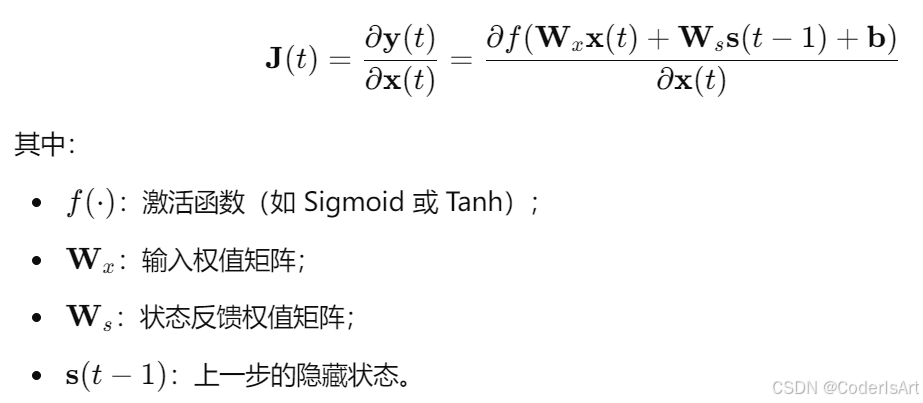DRNN 神经网络的 Jacobian 信息辨识
1. 基本原理
Jacobian 矩阵用于描述多输入多输出系统中输入和输出之间的偏导关系,其形式为:
对于 DRNN(Dynamic Recurrent Neural Network),其动态特性使得 y(t)\mathbf{y}(t)y(t) 依赖于当前输入 x(t) 和状态反馈 s(t−1)。
Jacobian 的计算扩展为:
-
离线/在线训练数据获取
- 离线模式:使用大量输入输出数据对 Jacobian 进行估计。
- 在线模式:实时更新 Jacobian 矩阵,用于动态调节控制参数。
3. 实现步骤
以下提供一个基于 C++ 和 Eigen 库的实现示例。
3.1 激活函数的导数
使用 Tanh 激活函数为例:
double tanhDerivative(double x) {
double tanhVal = tanh(x);
return 1.0 - tanhVal * tanhVal;
}
3.2 DRNN 类的扩展
在前向传播的基础上添加 Jacobian 计算方法。
#include <Eigen/Dense>
#include <vector>
#include <iostream>
#include <cmath>
using namespace std;
using namespace Eigen;
class DRNN {
private:
MatrixXd Wx, Ws; // 输入权值和状态反馈权值
VectorXd b; // 偏置
VectorXd state; // 当前隐藏状态
VectorXd z; // 网络输入(激活前)
double learningRate;
public:
DRNN(int inputSize, int outputSize, double lr)
: Wx(MatrixXd::Random(outputSize, inputSize)),
Ws(MatrixXd::Random(outputSize, outputSize)),
b(VectorXd::Random(outputSize)),
state(VectorXd::Zero(outputSize)),
z(VectorXd::Zero(outputSize)),
learningRate(lr) {}
// 前向传播
VectorXd forward(const VectorXd& input) {
z = Wx * input + Ws * state + b; // 网络输入
state = z.unaryExpr([](double x) { return tanh(x); }); // 激活函数
return state;
}
// 计算 Jacobian 矩阵
MatrixXd computeJacobian(const VectorXd& input) {
// 激活函数的导数
VectorXd activationDeriv = z.unaryExpr([](double x) { return 1.0 - tanh(x) * tanh(x); });
// 对角矩阵表示激活函数导数
MatrixXd diagActivationDeriv = activationDeriv.asDiagonal();
// 计算 Jacobian
return diagActivationDeriv * Wx;
}
};
3.3 主程序测试
使用 DRNN 模拟系统的 Jacobian 信息辨识。
int main() {
// 初始化 DRNN
int inputSize = 2, outputSize = 2;
DRNN drnn(inputSize, outputSize, 0.01);
// 测试输入
VectorXd input(inputSize);
input << 1.0, -0.5;
// 前向传播
VectorXd output = drnn.forward(input);
cout << "Output: " << output.transpose() << endl;
// 计算 Jacobian
MatrixXd jacobian = drnn.computeJacobian(input);
cout << "Jacobian Matrix:\n" << jacobian << endl;
return 0;
}
. 结果分析
- 输出结果:通过
forward获取输出值 y(t)\mathbf{y}(t)y(t); - Jacobian 矩阵:通过
computeJacobian计算出当前时刻输入对输出的敏感性。
示例结果
假设随机初始化权值和输入:
Output: 0.7616 -0.4621
Jacobian Matrix:
0.4190 0.0123
-0.0007 0.3101
5. 应用场景
- 动态控制:利用 Jacobian 辨识信息动态调整控制器参数。
- 解耦控制:辅助设计多输入多输出系统的解耦控制。
- 非线性系统建模:在线估计系统的非线性动态特性。
总结
基于 DRNN 的 Jacobian 信息辨识是一种有效的动态建模和控制工具。通过实时计算 Jacobian,能够捕捉系统的输入输出动态关系,广泛应用于复杂非线性、多变量系统的优化控制与解耦设计。


